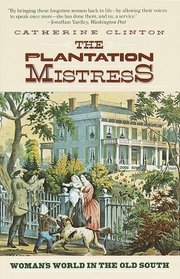Helpful Score: 2
This is a very interesting and enlightening book about women on plantations in the Old South. From the cover...This pioneering study of the much-mythologized Southern belle offers the first serious look at the lives of white women and their harsh and restricted place in the slave society before the Civil War. Drawing on the diaries, letters, and memoirs of hundreds of planter wives and daughters, Clinton sets before us in vivid detail the daily life of the plantation mistress and her ambiguous intermediary position in the hieracrchy between slave and master.
Dottie J. (pippin2) reviewed The Plantation Mistress: Woman's World in the Old South on + 48 more book reviews
Helpful Score: 2
Very interesting read regarding the role of women in the South before the Civil War. I am a living historian of that era and found out some very neat facts that I had not been aware of before.
Dottie J
Dottie J
Helpful Score: 1
This is not a book about Southern Belles! A study of the lives of white women on plantations with slaves before, during and after the Civil War.
Helpful Score: 1
This is the product of scholarly research in women's studies but is quite readable. The author diligently searched out letters and account books from many libraries as well as reading the 19th and 20th C. published material. In many cases, the lady was left to run the plantation (many of them not all that large) while her husband was away on business or political duties, even though women had few property rights and really could not travel by themselves other than to visit relatives.
It was often a rather lonely life (remember how bad the the roads were in, say, most of Alabama) and she had to see that sufficient food and clothing were produced to take care of the people of the plantation (and sometimes had to 'make' the cash crop). Weather killed some plants and there had to be replanting, in the late fall the hogs had to be slaughtered (she had the key to storage sheds), and the letters/diaries reveal that she did a lot of the sewing to outfit everyone twice a year. In general, relatively little was ordered ready-made. There was only some finishing school type of education offered to young women and it got worse as the North increasingly despised slavery, leading to these ladies being sent only to local academies.
I myself was interested in the business operations and did not read much in the other chapters about everything from marital relations to managing slaves.
It was often a rather lonely life (remember how bad the the roads were in, say, most of Alabama) and she had to see that sufficient food and clothing were produced to take care of the people of the plantation (and sometimes had to 'make' the cash crop). Weather killed some plants and there had to be replanting, in the late fall the hogs had to be slaughtered (she had the key to storage sheds), and the letters/diaries reveal that she did a lot of the sewing to outfit everyone twice a year. In general, relatively little was ordered ready-made. There was only some finishing school type of education offered to young women and it got worse as the North increasingly despised slavery, leading to these ladies being sent only to local academies.
I myself was interested in the business operations and did not read much in the other chapters about everything from marital relations to managing slaves.
A well-written, thoroughly researched account of what it meant to be a "southern plantation mistress" during the period 1780-1835.
If you ever thought you'd like to a "Scarlett O'Hara" at Tara, you're lucky you weren't. The true story is these women were overworked, under-educated, left alone for long periods of time while their husbands were away, and were just one step above the slaves themselves. Plus, they were expected to reproduce like rabbits. Which is one reason why many plantation owners went through two or three wives in their lifetime.
As expected, these women worked closely with Negro slaves, and their interactions with them are very closely examined in all respects.
This book confirms what I have read in numerous other books of this period and area, if you are a young lady, put off marrying for as long as possible, for after you are wed you are no longer treated as a prize to be obtained, but one to be used.
If you want a closer examination of these women during the late ante-bellum and Civil War era, then I suggest you read "Tara Revisited" by the same author.
If you ever thought you'd like to a "Scarlett O'Hara" at Tara, you're lucky you weren't. The true story is these women were overworked, under-educated, left alone for long periods of time while their husbands were away, and were just one step above the slaves themselves. Plus, they were expected to reproduce like rabbits. Which is one reason why many plantation owners went through two or three wives in their lifetime.
As expected, these women worked closely with Negro slaves, and their interactions with them are very closely examined in all respects.
This book confirms what I have read in numerous other books of this period and area, if you are a young lady, put off marrying for as long as possible, for after you are wed you are no longer treated as a prize to be obtained, but one to be used.
If you want a closer examination of these women during the late ante-bellum and Civil War era, then I suggest you read "Tara Revisited" by the same author.




![header=[] body=[Get a free book credit right now by joining the club and listing 5 books you have and are willing to share with other members!] Help icon](/images/question.gif?v=90afaeb39)
